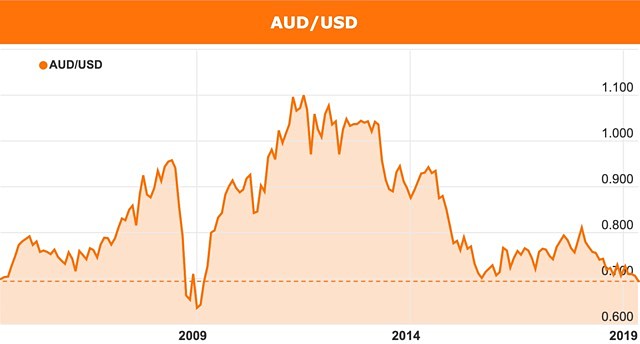Australian dollar continues to fall with more to come

The Australian dollar reached an all time high of US$1.10 in July of 2011, however is now trading under US69c.
There are four big reasons why the Australian dollar has been falling, with plenty of indications that the decline isn’t over yet.
The falls to below the US69c mark are fantastic news for Australian exporters but not so good for overseas holidaymakers and for consumers buying imported goods.
On the investment side, the declining dollar has boosted returns for Australians who have offshore investments due to the valuation rise

The Aussie dollar is retreating towards 10-year lows.
So, what is pushing the Aussie dollar lower?
Interest rates pushing the dollar down
The first reason is that Australian interest rates have been falling.
In a direct way that reduces the relative attraction of investing in Australia versus other countries.
If you can get a risk-free return of 3% in one country and 2% in another, the higher interest rate is more desirable and all other things being equal, it will enjoy more foreign investment and a stronger currency.
Slowing growth cuts the currency
We may have just come through an election in which Australia’s “strong economy’’ was a major selling point but it has become increasingly apparent that things are actually quite crook here.
Australia’s latest growth figures have been the weakest since the GFC, with the economy up just 1.8% in the year to March.
Even that number is boosted by immigration and government infrastructure spending, which has kept the numbers positive.
In per capita terms growth has been negative for three quarters.
Lower growth is also a disincentive for foreign investors who want to put their money where growth is strong and sustainable.
Iron ore boom finally decouples from falling dollar
One of the factors that has been keeping the Australian dollar stronger than it might have been has been the booming iron ore price.
Australia holds a dominant position in the world seaborne iron ore market through companies such as BHP, Rio Tinto and Fortescue Metals and having such a strong export performance increases government tax revenue and is an attraction for foreign investors.
However, the Australian dollar has now decoupled from the iron ore price.
While iron ore has been trading around five-year highs above US$110 a tonne, the dollar has been falling.
Many forecasters are looking past the current tight iron ore market in China to falling Chinese steel mill margins which eventually will need to be improved by either lower raw material prices or even higher steel prices.
Out of those two possibilities, lower iron ore prices seem the most likely, with some iron ore bears seeing the price falling to US$80/t by the end of this year.
Interest rate direction differentials
It is not just falling interest rates that have been pushing the dollar down – it is also the emerging divergence in the policies of various governments.
One strong example has been the relationship between the Australian dollar and the Japanese Yen – with larger relative losses compared with other major currencies as Japan is seen to be in a stronger relative position.
While it is true that Japan still has an incredibly accommodative monetary policy with official interest rates at negative 0.1%, it’s still holding interest rates steady while Australia is widely expected to cut at least once and possibly twice this year.
It is a similar interest rate differential with the US.
While the US Fed has signalled that it is open to cutting rates, Australia is seen as more likely to cut rates earlier.
That is particularly the case since a string of US economic numbers that have been stronger than expected, including retail sales, consumer spending and core retail sales.
That makes it much more likely for the US to delay cutting rates until there are more signs of weakness in their economy.
